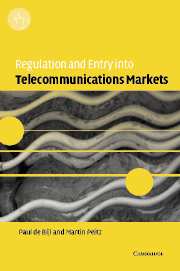Book contents
- Frontmatter
- Contents
- List of figures
- List of tables
- Preface
- Frequently used symbols
- License agreement and warranty disclaimer
- 1 Introduction
- 2 Telecommunications
- 3 The basic model
- 4 Facilities-based entry in a non-segmented market
- 5 Non-facilities-based entry in a non-segmented market
- 6 Entry in a non-segmented market: alternative pricing strategies
- 7 Non-targeted entry in a segmented market
- 8 Targeted entry
- 9 Concluding remarks
- Appendix: sample simulation program
- Bibliography
- Index
5 - Non-facilities-based entry in a non-segmented market
Published online by Cambridge University Press: 22 September 2009
- Frontmatter
- Contents
- List of figures
- List of tables
- Preface
- Frequently used symbols
- License agreement and warranty disclaimer
- 1 Introduction
- 2 Telecommunications
- 3 The basic model
- 4 Facilities-based entry in a non-segmented market
- 5 Non-facilities-based entry in a non-segmented market
- 6 Entry in a non-segmented market: alternative pricing strategies
- 7 Non-targeted entry in a segmented market
- 8 Targeted entry
- 9 Concluding remarks
- Appendix: sample simulation program
- Bibliography
- Index
Summary
Introduction
Whereas the previous chapter explored facilities-based entry, in this chapter we examine two alternative modes of entry, namely:
1. local-loop-unbundling-based entry: the entrant has a network consisting of a long-distance backbone, and leases local lines from the incumbent;
2. carrier-select-based entry: the entrant has a network consisting of a long-distance backbone, and serves end users through originating access to the incumbent's customer access network.
Taken together with facilities-based entry analyzed in the previous chapter, these three modes of entry represent the range of levels of investment required for entry in the market, going from entry that requires the largest investments in the local loop, to an entry mode that is relatively easy. Correspondingly, we speak of facilities-based competition (FBC), local-loop-unbundling-based competition (LLU), and carrier-select-based competition (CSC). Thus, instead of the duplication of the local loop under FBC, there can be unbundled or resale-based access to the local loop. In each case, the regulatory instruments that apply in that situation will be analyzed. Note that FBC is a situation of two-way access, whereas CSC is a situation of one-way access. Concerning the subscription of consumers, LLU is also a situation of one-way access (with regard to unbundled access to the local loop) but, for given consumer subscriptions, it is a situation of two-way access (with regard to terminating access to end users). The regulatory burden is larger in the case of LLU and CSC than in the case of FBC.
- Type
- Chapter
- Information
- Regulation and Entry into Telecommunications Markets , pp. 114 - 141Publisher: Cambridge University PressPrint publication year: 2003



